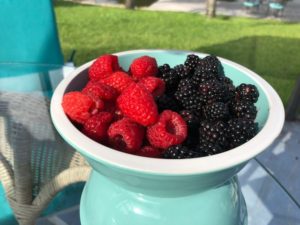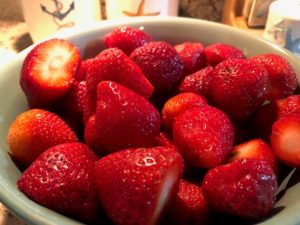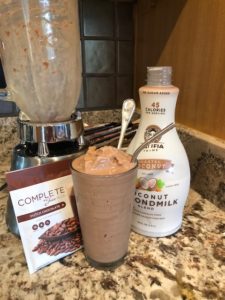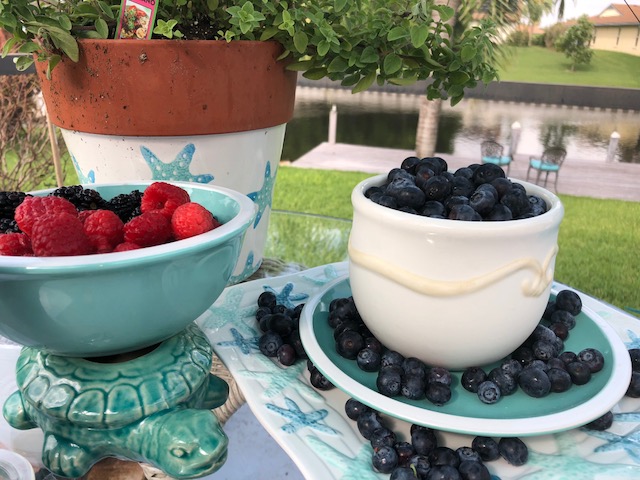BERRIES ~ I remember as a kid one of our neighbors had bushes of berries growing in their yard. We used to love to go pick and eat those fresh delicious super-foods right from the stem. There’s nothing as good as fresh foods picked straight from nature.
I could say so much about these wonderful gifts of nature. Not only are they tasty, but the list of health benefits is a long one. Berries are packed full of antioxidants, flavonoids, polyphenols, phytonutrients (i.e.,phytochemicals), quercetin (flavonoid), Salicylic acid (found in cranberries), gallic acid (powerful antioxidant), ellagic acid (potent anti-carcinogen), catechins (flavonoids), anthocyanins and ellagitannins (powerful phytochemicals), and rutin (bioflavonoid). These wonderful and colorful foods help to complete the rainbow of foods that are very important in our everyday diet. Berries are low in calories and are high in moisture and fiber. They also contain vitamin C and E, also known as natural antioxidants, in addition, micronutrients such as folic acid, calcium, selenium, alpha and beta-carotene, and lutein (Basu, Rhone, & Lyons, 2010).
Not only do these incredible berries provide nourishment, but they are also able to protect the body from environmental stressors and pests. One benefit is these protective agents are able to guard the body by stimulating enzymes to help support the immune system, promote estrogen metabolism, improve cardiovascular health, even get rid of toxins and eradicate cancer cells. Berries are also wonderful brain foods. “Berry fruits possess neuroavailable, neuroactive phytochemicals that offer antioxidant, anti-inflammatory, and having direct effects on the brain” (“Berry Fruit Enhances Beneficial Signaling in the Brain,” n.d.). Furthermore, supplementation with berry fruits reduces serum oxidative and inflammatory markers in humans and, in the case of grapes and blueberries, improves cognition among older adults with MCI (mild cognitive impairment is a stroke risk factor dementia(“Berry Fruit Enhances Beneficial Signaling in the Brain,” n.d.). Recently, I read an article supporting how resveratrol is found in a variety of many berries, grapes, and red wine; making these the richest sources of resveratrol in a typical human diet. Furthermore, due to the antioxidant and anti-inflammatory activities found in resveratrol – tissue damage to the liver, kidney, and brain caused by oxidative stress and inflammation may be neutralized.
 In favor of the immune system it was also shown in one randomized, double-blinded, control clinical trial, of 50 confirmed Non-Alcoholic Fatty Liver Disease (NAFLD) patients that after taking 500 mg per day of resveratrol for 12 weeks, to include an energy-balanced diet and follow physical activity recommendations their serum ALT, TNF-α (is a cell signaling protein (cytokine) involved in systemic inflammation), IL-6 (is an interleukin that acts as both a pro-inflammatory cytokine and an anti-inflammatory myokine), cytokeratin-18 M30 (important in cell signaling), peripheral blood mononuclear cell NF-kB (protein complex involved in controlling transcription of DNA) activity, hepatic tissue echogenicity (ability to bounce an echo) assessed by ultrasound, and hepatic steatosis (increase build-up of fat in the liver) grade were significantly reduced in the resveratrol group and no adverse effects were reported by the study patients(Bagherniya, Nobili, Blesso, & Sahebkar, 2018).
Anthocyanins are incredible bioactive compounds that belong to the flavonoid subclass of polyphenols. The berries listed in the article are those of the color red, purple, and blue. Anthocyanin can also be found in many other fruits, vegetables, flowers, and cereal grains. The case in point is with berry fruits, including blackberries, blueberries, and strawberries, are considered one of the richest foods sources of anthocyanins. This is important because the antioxidant activity directly enables anthocyanins to scavenge reactive oxygen species and free radicals, and also modulate endogenous antioxidant defense, which may ultimately be a contributing factor in the prevention of oxidative stress (Bagherniya et al., 2018).
Like I said, there’s so much more that can be said, but for the sake of being too long-winded, we will leave it at a few benefits of consuming berries and a delicious way you can start adding them into your diet today.
In favor of the immune system it was also shown in one randomized, double-blinded, control clinical trial, of 50 confirmed Non-Alcoholic Fatty Liver Disease (NAFLD) patients that after taking 500 mg per day of resveratrol for 12 weeks, to include an energy-balanced diet and follow physical activity recommendations their serum ALT, TNF-α (is a cell signaling protein (cytokine) involved in systemic inflammation), IL-6 (is an interleukin that acts as both a pro-inflammatory cytokine and an anti-inflammatory myokine), cytokeratin-18 M30 (important in cell signaling), peripheral blood mononuclear cell NF-kB (protein complex involved in controlling transcription of DNA) activity, hepatic tissue echogenicity (ability to bounce an echo) assessed by ultrasound, and hepatic steatosis (increase build-up of fat in the liver) grade were significantly reduced in the resveratrol group and no adverse effects were reported by the study patients(Bagherniya, Nobili, Blesso, & Sahebkar, 2018).
Anthocyanins are incredible bioactive compounds that belong to the flavonoid subclass of polyphenols. The berries listed in the article are those of the color red, purple, and blue. Anthocyanin can also be found in many other fruits, vegetables, flowers, and cereal grains. The case in point is with berry fruits, including blackberries, blueberries, and strawberries, are considered one of the richest foods sources of anthocyanins. This is important because the antioxidant activity directly enables anthocyanins to scavenge reactive oxygen species and free radicals, and also modulate endogenous antioxidant defense, which may ultimately be a contributing factor in the prevention of oxidative stress (Bagherniya et al., 2018).
Like I said, there’s so much more that can be said, but for the sake of being too long-winded, we will leave it at a few benefits of consuming berries and a delicious way you can start adding them into your diet today.
 Benefits:
Benefits:
 Before I knew better when I fed my family strawberry shortcakes and/or pineapple upside down cake I thought I was providing my family with a great way to enjoy fruit. Of course, there are better ways to still enjoy these treats, but in a much healthier way than the typical white flour and sugar. These ideas may be a great opportunity for alternative recipes at a later date. But for now, at the end of the day, I do believe we all attempt to do the best we can to eat healthily. However, with busy lifestyles I find that most people have a difficult time with juggling families, work, and life, in general, to include providing healthy meals to their family.
This post only touched on some of the ways berries can contribute to the prevention and potential reduced risk factors when it comes to disease. Even knowing this isn’t enough for some to take the initiative to consume more. Thus, is one of my reasons why I always like to provide my clients with real, convenient solutions to add to their families’ healthy lifestyle needs. But first, I want to be clear; enjoying the actual foods we can place on our table is the first way to becoming healthy. However, for many of the reasons I mentioned above even that will not be enough. Unfortunately, many of our berries have some of the highest ratings of pesticides, herbicides and other toxic chemicals known to cause disease. Per the Environmental Working Group (EWG) website domestic blueberries tested positive for 42 different pesticide residues, and 73 percent of the blueberries contained two or more pesticides. Strawberries have been found at the top of the “Dirty Dozen” list for several years due to them being contaminated with pesticide residues. Per EWG a single strawberry sample contained 20 different types of pesticides (Group, n.d.). But we can’t negate the fact that soil is depleted of needed nutrients too, so, if the plant is not getting fed properly than neither are we when we eat them.
Berries are just one whole food nutrient dense source that is needed to achieve a well-balanced diet. In the case of this article check-out the berry blend product (the purple cap) in the 4.5-minute video below. This product is an easy, convenient, affordable way to incorporate berries into your diet along with other plant-based choices. See how easy it can be to bridge the gap between what your diet may be lacking in good nutrition.
I thought I would share this amazing chocolate berry smoothie with you.
Before I knew better when I fed my family strawberry shortcakes and/or pineapple upside down cake I thought I was providing my family with a great way to enjoy fruit. Of course, there are better ways to still enjoy these treats, but in a much healthier way than the typical white flour and sugar. These ideas may be a great opportunity for alternative recipes at a later date. But for now, at the end of the day, I do believe we all attempt to do the best we can to eat healthily. However, with busy lifestyles I find that most people have a difficult time with juggling families, work, and life, in general, to include providing healthy meals to their family.
This post only touched on some of the ways berries can contribute to the prevention and potential reduced risk factors when it comes to disease. Even knowing this isn’t enough for some to take the initiative to consume more. Thus, is one of my reasons why I always like to provide my clients with real, convenient solutions to add to their families’ healthy lifestyle needs. But first, I want to be clear; enjoying the actual foods we can place on our table is the first way to becoming healthy. However, for many of the reasons I mentioned above even that will not be enough. Unfortunately, many of our berries have some of the highest ratings of pesticides, herbicides and other toxic chemicals known to cause disease. Per the Environmental Working Group (EWG) website domestic blueberries tested positive for 42 different pesticide residues, and 73 percent of the blueberries contained two or more pesticides. Strawberries have been found at the top of the “Dirty Dozen” list for several years due to them being contaminated with pesticide residues. Per EWG a single strawberry sample contained 20 different types of pesticides (Group, n.d.). But we can’t negate the fact that soil is depleted of needed nutrients too, so, if the plant is not getting fed properly than neither are we when we eat them.
Berries are just one whole food nutrient dense source that is needed to achieve a well-balanced diet. In the case of this article check-out the berry blend product (the purple cap) in the 4.5-minute video below. This product is an easy, convenient, affordable way to incorporate berries into your diet along with other plant-based choices. See how easy it can be to bridge the gap between what your diet may be lacking in good nutrition.
I thought I would share this amazing chocolate berry smoothie with you.
 Chocolate-Berry Heaven Smoothie:
Chocolate-Berry Heaven Smoothie:
 In favor of the immune system it was also shown in one randomized, double-blinded, control clinical trial, of 50 confirmed Non-Alcoholic Fatty Liver Disease (NAFLD) patients that after taking 500 mg per day of resveratrol for 12 weeks, to include an energy-balanced diet and follow physical activity recommendations their serum ALT, TNF-α (is a cell signaling protein (cytokine) involved in systemic inflammation), IL-6 (is an interleukin that acts as both a pro-inflammatory cytokine and an anti-inflammatory myokine), cytokeratin-18 M30 (important in cell signaling), peripheral blood mononuclear cell NF-kB (protein complex involved in controlling transcription of DNA) activity, hepatic tissue echogenicity (ability to bounce an echo) assessed by ultrasound, and hepatic steatosis (increase build-up of fat in the liver) grade were significantly reduced in the resveratrol group and no adverse effects were reported by the study patients(Bagherniya, Nobili, Blesso, & Sahebkar, 2018).
Anthocyanins are incredible bioactive compounds that belong to the flavonoid subclass of polyphenols. The berries listed in the article are those of the color red, purple, and blue. Anthocyanin can also be found in many other fruits, vegetables, flowers, and cereal grains. The case in point is with berry fruits, including blackberries, blueberries, and strawberries, are considered one of the richest foods sources of anthocyanins. This is important because the antioxidant activity directly enables anthocyanins to scavenge reactive oxygen species and free radicals, and also modulate endogenous antioxidant defense, which may ultimately be a contributing factor in the prevention of oxidative stress (Bagherniya et al., 2018).
Like I said, there’s so much more that can be said, but for the sake of being too long-winded, we will leave it at a few benefits of consuming berries and a delicious way you can start adding them into your diet today.
In favor of the immune system it was also shown in one randomized, double-blinded, control clinical trial, of 50 confirmed Non-Alcoholic Fatty Liver Disease (NAFLD) patients that after taking 500 mg per day of resveratrol for 12 weeks, to include an energy-balanced diet and follow physical activity recommendations their serum ALT, TNF-α (is a cell signaling protein (cytokine) involved in systemic inflammation), IL-6 (is an interleukin that acts as both a pro-inflammatory cytokine and an anti-inflammatory myokine), cytokeratin-18 M30 (important in cell signaling), peripheral blood mononuclear cell NF-kB (protein complex involved in controlling transcription of DNA) activity, hepatic tissue echogenicity (ability to bounce an echo) assessed by ultrasound, and hepatic steatosis (increase build-up of fat in the liver) grade were significantly reduced in the resveratrol group and no adverse effects were reported by the study patients(Bagherniya, Nobili, Blesso, & Sahebkar, 2018).
Anthocyanins are incredible bioactive compounds that belong to the flavonoid subclass of polyphenols. The berries listed in the article are those of the color red, purple, and blue. Anthocyanin can also be found in many other fruits, vegetables, flowers, and cereal grains. The case in point is with berry fruits, including blackberries, blueberries, and strawberries, are considered one of the richest foods sources of anthocyanins. This is important because the antioxidant activity directly enables anthocyanins to scavenge reactive oxygen species and free radicals, and also modulate endogenous antioxidant defense, which may ultimately be a contributing factor in the prevention of oxidative stress (Bagherniya et al., 2018).
Like I said, there’s so much more that can be said, but for the sake of being too long-winded, we will leave it at a few benefits of consuming berries and a delicious way you can start adding them into your diet today.
 Benefits:
Benefits:
- Cardiovascular: It is well known by most that eating fruits and vegetables are correlated with a decreased risk of cardiovascular disease (CVD). The “National health objectives reflect in Healthy People 2010 advocate increasing fruit consumption by more than 75 percent or to at least two servings per day in persons 2 years of age and older…Clinical human studies, using subjects with diabetes mellitus, dyslipidemia, metabolic syndrome, hypertension, or in smokers, show a significant decrease in CVD risk factors, especially glucose, lipids, and lipid peroxidation, and systolic blood pressure, following berry intervention”(Basu et al., 2010).
- High in fiber and supports healthy digestion: One study showed the components in cranberry might inhibit adhesion of bacteria such as H. pylori to the lining of the stomach. In a double-blind, randomized study patients with H. pylori used cranberry juice. It was shown the cranberry juice significantly reduced H. pylori infections in 14.4% of the patients compared with the placebo groups, which showed only 5.4% reduction. (Govers, Berkel Kasikci, Sluis, A, & Mes, 2018).
- Oral Health: There is not a whole lot of research on oral health and berries. I will share a few.
- Gingivitis is an early sign of periodontal disease. A human study showed that bilberries reduced gum bleeding and inflammation. The results of reduced gingival inflammation to levels similar to those of standard, more invasive care.
- Leucoplakia involves premalignant white lesions in the mucosa. High doses of vitamin C, as found in berries reduced the overall clinical response rate.
- Oral cancer risk factors in a controlled study involving 2886 individuals. The dietary intake of flavonoids helps to lower the risk of developing oral cancer.
- Black raspberry tested in human trials in which oral squamous cell carcinoma was treated with oral application of a freeze-dried product. Results revealed a significant (P-<0.05) reduction in antiapoptotic and pro-inflammatory markers in biopsies(Govers et al., 2018)
- Consuming berries may help improve blood sugar by increasing insulin sensitivity:(Mozaffarian & Wu, 2018).
- Weight Maintenance: Flavonoids prevented diet-induced weight gain in several animal models of obesity. The flavonoids did not appear to influence energy intake, suggesting that they may contribute to weight regulation by increasing energy expenditure (Mozaffarian & Wu, 2018).
- Fights inflammation: Some flavonoids have demonstrated anti-inflammatory properties in adipose and myocardial tissues(Mozaffarian & Wu, 2018).
- Cognitive: In an epidemiologic study from the Nurse’s Health Study, consisting of 16,010 women showed an association with a greater intake of blueberries and strawberries positively correlated with slower rates of cognitive decline. In addition, it was concluded that berry intake delayed cognitive aging by up to 2.5 years (Pribis & Shukitt-Hale, 2014).
- Cancer-fighting properties: I think the information found in one particular article is worth its weight in gold. Both of my parents passed away from cancer way before their time, so this topic is close to my heart. Per the World Health Organization (WHO) global report (World Cancer Report 2024, as updated in 2015) “cancer is one of the leading causes of mortality worldwide, reaching approximately 14 million new cases and 8.2 million causes of morbidity and mortality worldwide, reaching approximately 14 million new cases and 8.2 million cancer-related deaths in 2012. While new cancer incidence is expected to rise by 70 percent by the year 2034 approximately 35 percent of cancer deaths are attributed to the five leading behavioral and dietary risks:
- High body mass index (BMI)
- Low fruit and vegetable intake
- Lack of physical activity
- Tobacco use (primarily smoking)
- Harmful alcohol use
- Dietary patterns including consumption of foods containing bioactive compounds such as mentioned above, berries have specific molecular and cellular protection in addition to the overall benefits such as obesity, chronic disease prevention.
- These health benefits are typically attributed to the non-nutritive bioactive compounds, again mentioned above. Mainly phenolic substances such as flavonoids or anthocyanins.
- These compounds found in berries extend their effects on the proliferation rates of both premalignant and malignant cells (Kristo, Klimis-Zacas, & Sikalidis, 2016).
 Before I knew better when I fed my family strawberry shortcakes and/or pineapple upside down cake I thought I was providing my family with a great way to enjoy fruit. Of course, there are better ways to still enjoy these treats, but in a much healthier way than the typical white flour and sugar. These ideas may be a great opportunity for alternative recipes at a later date. But for now, at the end of the day, I do believe we all attempt to do the best we can to eat healthily. However, with busy lifestyles I find that most people have a difficult time with juggling families, work, and life, in general, to include providing healthy meals to their family.
This post only touched on some of the ways berries can contribute to the prevention and potential reduced risk factors when it comes to disease. Even knowing this isn’t enough for some to take the initiative to consume more. Thus, is one of my reasons why I always like to provide my clients with real, convenient solutions to add to their families’ healthy lifestyle needs. But first, I want to be clear; enjoying the actual foods we can place on our table is the first way to becoming healthy. However, for many of the reasons I mentioned above even that will not be enough. Unfortunately, many of our berries have some of the highest ratings of pesticides, herbicides and other toxic chemicals known to cause disease. Per the Environmental Working Group (EWG) website domestic blueberries tested positive for 42 different pesticide residues, and 73 percent of the blueberries contained two or more pesticides. Strawberries have been found at the top of the “Dirty Dozen” list for several years due to them being contaminated with pesticide residues. Per EWG a single strawberry sample contained 20 different types of pesticides (Group, n.d.). But we can’t negate the fact that soil is depleted of needed nutrients too, so, if the plant is not getting fed properly than neither are we when we eat them.
Berries are just one whole food nutrient dense source that is needed to achieve a well-balanced diet. In the case of this article check-out the berry blend product (the purple cap) in the 4.5-minute video below. This product is an easy, convenient, affordable way to incorporate berries into your diet along with other plant-based choices. See how easy it can be to bridge the gap between what your diet may be lacking in good nutrition.
I thought I would share this amazing chocolate berry smoothie with you.
Before I knew better when I fed my family strawberry shortcakes and/or pineapple upside down cake I thought I was providing my family with a great way to enjoy fruit. Of course, there are better ways to still enjoy these treats, but in a much healthier way than the typical white flour and sugar. These ideas may be a great opportunity for alternative recipes at a later date. But for now, at the end of the day, I do believe we all attempt to do the best we can to eat healthily. However, with busy lifestyles I find that most people have a difficult time with juggling families, work, and life, in general, to include providing healthy meals to their family.
This post only touched on some of the ways berries can contribute to the prevention and potential reduced risk factors when it comes to disease. Even knowing this isn’t enough for some to take the initiative to consume more. Thus, is one of my reasons why I always like to provide my clients with real, convenient solutions to add to their families’ healthy lifestyle needs. But first, I want to be clear; enjoying the actual foods we can place on our table is the first way to becoming healthy. However, for many of the reasons I mentioned above even that will not be enough. Unfortunately, many of our berries have some of the highest ratings of pesticides, herbicides and other toxic chemicals known to cause disease. Per the Environmental Working Group (EWG) website domestic blueberries tested positive for 42 different pesticide residues, and 73 percent of the blueberries contained two or more pesticides. Strawberries have been found at the top of the “Dirty Dozen” list for several years due to them being contaminated with pesticide residues. Per EWG a single strawberry sample contained 20 different types of pesticides (Group, n.d.). But we can’t negate the fact that soil is depleted of needed nutrients too, so, if the plant is not getting fed properly than neither are we when we eat them.
Berries are just one whole food nutrient dense source that is needed to achieve a well-balanced diet. In the case of this article check-out the berry blend product (the purple cap) in the 4.5-minute video below. This product is an easy, convenient, affordable way to incorporate berries into your diet along with other plant-based choices. See how easy it can be to bridge the gap between what your diet may be lacking in good nutrition.
I thought I would share this amazing chocolate berry smoothie with you.
 Chocolate-Berry Heaven Smoothie:
Chocolate-Berry Heaven Smoothie:
- 1 cup of almond/coconut milk (I use the one pictured. It doesn’t contain carrageenan)
- ½ cup of fresh frozen blueberries and strawberries
- 1 scoop of Juice Plus meal replacement (or package if you purchase single packages) chocolate or vanilla is good too
- 1 tsp of honey or manuka honey (organic/local)
- ¼ cup (may need a little more) ice

